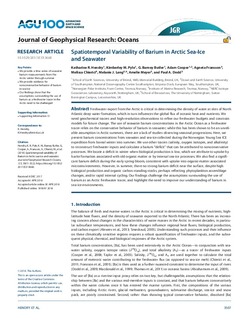| dc.description.abstract | Freshwater export from the Arctic is critical in determining the density of water at sites of North Atlantic deep water formation, which in turn influences the global flux of oceanic heat and nutrients. We need geochemical tracers and high‐resolution observations to refine our freshwater budgets and constrain models for future change. The use of seawater barium concentrations in the Arctic Ocean as a freshwater tracer relies on the conservative behavior of barium in seawater; while this has been shown to be an unreliable assumption in Arctic summers, there are a lack of studies observing seasonal progressions. Here, we present barium concentrations from seawater and sea‐ice collected during the Norwegian Young Sea ICE expedition from boreal winter into summer. We use other tracers (salinity, oxygen isotopes, and alkalinity) to reconstruct freshwater inputs and calculate a barium “deficit” that can be attributed to nonconservative processes. We locate a deficit in winter when biological production is low, which we attribute to uptake by barite formation associated with old organic matter or by internal sea‐ice processes. We also find a significant barium deficit during the early spring bloom, consistent with uptake into organic‐matter associated microenvironments. However, in summer, there no strong barium deficit near the surface, despite high biological production and organic carbon standing stocks, perhaps reflecting phytoplankton assemblage changes, and/or rapid internal cycling. Our findings challenge the assumptions surrounding the use of barium as an Arctic freshwater tracer, and highlight the need to improve our understanding of barium in sea‐ice environments. | nb_NO |
